Key:barrier
 |
| Description |
|---|
| A barrier is a physical structure which blocks or impedes movement. |
| Group: barriers |
| Used on these elements |
| Documented values: 68 |
| Implies |
|
| Useful combination |
| Status: approved |
| Tools for this tag |
|
A barrier is a physical structure which blocks or impedes movement. The barrier tag only covers on-the-ground barriers. It does not cover typical waterway barriers (dams, waterfalls, etc.). However, barriers that are normally found on land (such as fences) can also be found (and thus tagged) in water.
How to map barrier nodes
Place on a highway or a barrier way or at the common node between a highway or a barrier way (if it's part of both). Do not place a barrier tag on a junction between highways.
| Example in iD editor |
|
| Example in JOSM editor |
|
Values
| Key | Value | Element | Comment | carto-Rendering | Photo | |
|---|---|---|---|---|---|---|
Linear barriers (e.g. along a path or road) | ||||||
| barrier | cable_barrier | Also called guard cable. This is a road side or median barrier made of steel wire ropes mounted on weak posts. See also the more extensive Wikipedia description. |  | |||
| barrier | city_wall | A fortification used to defend a city or settlement from potential aggressors.
From ancient to modern times, they are used to enclose settlements.
See also historic=city_gate, historic=citywalls and defensive_works=*. |
 |
 | ||
| barrier | ditch | A trench, ditch or ravine, that is not easily crossed, especially not on foot. Possibly water can flow at the bottom, so it can be used in combination with waterway=stream or waterway=drain. |  |
 | ||
| barrier | fence | A structure supported by posts driven into the ground and designed to prevent movement across a boundary. It is distinguished from a wall by the lightness of its construction. Use fence_type=* to add details. |  |
 | ||
| barrier | guard_rail | A guard_rail, also called a crash barrier. Right side is inner, left side is outer. |  |
 | ||
| barrier | handrail | Is designed to be grasped by the hand so as to provide stability or support. |  |
 | ||
| barrier | hedge | Is a line of closely spaced shrubs and bushes, planted and trained in such a way as to form a barrier or to mark the boundary of an area. |  |
 | ||
| barrier | retaining_wall | Retaining walls serve to retain the lateral pressure of soil. Right side is bottom, left side is top. |  |
 | ||
| barrier | wall | A free-standing solid structure designed to restrict or prevent movement across a boundary. Usually made from solid brick, concrete or stone and almost always built so that it is opaque to vision. Add wall=noise_barrier to tag an acoustic screens located along streets or roads |  |
 | ||
Access control on highways (e.g. for blocking a path or road) | ||||||
| barrier | block | A large, solid, immobile block that can be moved only with heavy machinery or great effort.
Typically big solid things made of concrete for stopping larger vehicles. Sometimes natural boulders are used for the same purpose. |
 | |||
| barrier | bollard | One or more solid (usually concrete or metal) pillar(s) used to control traffic. |  | |||
| barrier | border_control | This is a control point at an international border between two countries. Passports or other forms of ID will be checked. |  | |||
| barrier | bump_gate | For description see wikipedia:Bump gate, for another photo see flickr example: [1] . |  | |||
| barrier | bus_trap | See wikipedia:Bus trap. |  | |||
| barrier | cattle_grid | Bars in the road surface that allow wheeled vehicles but not animals to cross.
Sometimes known as a Texas Gate, even outside of Texas. |
 | |||
| barrier | coupure | A cut through a flood protection feature (e.g., (flood)wall, levee, or dyke) for a road or railway, that is readily made flood tight if required. | 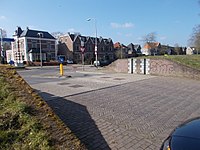 | |||
| barrier | cycle_barrier | Barriers to bicycle traffic, most typically a pair of staggered steel bars perpendicular to the way itself whose gaps allow pedestrians to pass. Cyclists may pass, but only at very reduced speed. May be installed ahead of a hazard, such as a road or rail crossing. |  | |||
| barrier | debris | A road is blocked by debris with or without ground. This might be for short or long time. Often used as first step in blocking an abandoned road. |  | |||
| barrier | entrance | A gap in a linear barrier with nothing that limits passing through.
access=yes is implied. The limitations are the same of the way that crosses it, if there is such. |
 | |||
| barrier | full-height_turnstile | A full-height turnstile, also called HEET-turnstile (high entrance/exit turnstile), like the ones to access security areas. Note the mix of hyphen and underscore. |  | |||
| barrier | gate | An entrance that can be opened or closed to get through the barrier. For a permanent opening in the barrier, see barrier=entrance.
Combine with access=* where appropriate. |
 | |||
| barrier | hampshire_gate | A section of wire fence which can be removed temporarily.
Combine with access=* where appropriate. |
 | |||
| barrier | height_restrictor | Combine with maxheight=*. |  | |||
| barrier | horse_stile | A horse stile allows pedestrians and horses to cross a gap through a fence, but prevents or makes it very difficult for motorcycles and live stock to cross. |  | |||
| barrier | kent_carriage_gap | A Kent carriage gap is used by local authorities in the UK to prevent motorised vehicles from accessing public rights of way whilst allowing most horse drawn carriages to pass.
These are now becoming common on byways in the UK. |
[2] | |||
| barrier | kissing_gate | A gate which allows people to cross, but not livestock. | 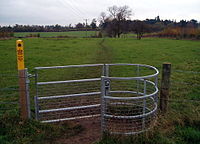 | |||
| barrier | lift_gate | A lift gate (boom barrier) is a bar, or pole pivoted in such a way as to allow the boom to block vehicular access through a controlled point.
Combine with access=* where appropriate. |
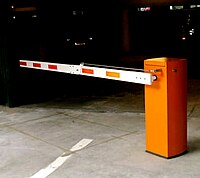 | |||
| barrier | motorcycle_barrier | Barriers along paths that prevent access by motorcycles. |  | |||
| barrier | planter | A plant box, or simply a planter, is a structure containing plants for decoration, which (in this context) has the primary purpose of preventing large vehicles from passing. |  | |||
| barrier | sally_port | A sally port is used to pass through thick or city walls, and is a type of covered gate with two doors. | 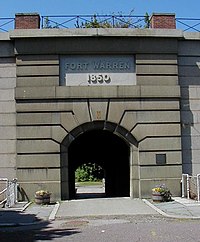 | |||
| barrier | sliding_beam | Something between barrier=sliding_gate and barrier=lift_gate: it has a quite thin bar like in lift gate, but the bar slides aside to allow through. |  | |||
| barrier | sliding_gate | Gates open sideways; usually automatic.
Combine with access=* where appropriate. |
 | |||
| barrier | spikes | Spikes on the ground that prevent unauthorized access. Can also be removable; e.g., after payment in a garage. |  | |||
| barrier | stile | A stile allows pedestrians to cross a wall or fence, but never actually "opens" the barrier.
(Unlike a gate, a stile has few or no moving parts.) |
 | |||
| barrier | sump_buster | A sump buster is a concrete slab or steel structure that prevents passing of two-tracked vehicles with less than a minimum track and ground clearance. (Typically stops normal cars.) |  | |||
| barrier | swing_gate | Similar to a lift gate but rotates sidewards to open. It is usually made out of metal bars (wood or other material possible) and is intended to prevent cars from access but can usually be crossed by pedestrians and cyclists. |  | |||
| barrier | toll_booth | A road usage toll or fee is collected here. Used with toll=* and charge=*. |  | |||
| barrier | turnstile | A turnstile (also called baffle gate) is used to allow one person at a time to pass. Use this for small turnstiles like the ones in supermarkets or some subways. |  | |||
| barrier | wedge | A wedge-shaped barrier that rises out of the ground to block traffic. |  | |||
| barrier | wicket_gate | A wicket gate, or simply a wicket, is a pedestrian door or gate, particularly one built into a larger door or into a wall or fence. |  | |||
| barrier | yes | A barrier which nature cannot be determined; typically only used in mapping using aerial imagery. Should be replaced by a specific value. |  | |||
Linear barriers or access control on highways (e.g., along or for blocking a path or road) | ||||||
| Key | Value | Element | Comment | Photo for along | carto-Rendering | Photo for blocking |
| barrier | bar | A fixed horizontal bar which blocks motor vehicles but can usually be bypassed on foot or bike. Often placed at trailheads. |  | |||
| barrier | barrier_board | A barrier board to restrict the passage of a way or to block off an area. |  | |||
| barrier | bollard | Solid (usually concrete or metal) pillar or pillars in the middle of the road to prevent passage by some traffic. See bollard=*. |  |
 | ||
| barrier | chain | A chain used to prevent motorised vehicles. |  |
 | ||
| barrier | jersey_barrier | A Jersey barrier consists of heavy prefabricated blocks to create a barrier. Use material=plastic or material=concrete to express the used material. |  |
 |
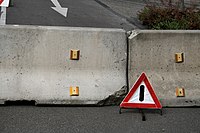 | |
| barrier | kerb | A kerb (or curb) is a short solid barrier, usually found at the edge of a road, path, or sidewalk, which prevents entrance by vehicles and wheelchair users. The height of the kerb is tagged additionally as height=*, if available. Right side is bottom, left side is top. |  | |||
| barrier | log | Use this when the passage is barred by lumber (trunk of a tree). This kind of barrier is often also a bench. This barrier partially blocks cyclists but can be crossed by lifting the bike over. |  | |||
| barrier | rope | A flexible barrier made of fibres, twisted or braided together to improve strength. As a barrier it is often more symbolic than actually physically preventing pedestrians from accessing. |  | |||
| barrier | tank_trap | Static anti-tank obstacles that can take various forms, such as Czech hedgehog (barrier=tank_trap; tank_trap=czech_hedgehog). |  | |||
| barrier | tyres | A crash barrier made from tyres stacked on top of each other, commonly found at motor racing circuits. |  | |||
| barrier | delineators | A barrier made of plastic/rubber posts, common on one-way two-lane roads where overtaking is prohibited, or on busy roads to prevent forbidden turns or parking along the curb. | 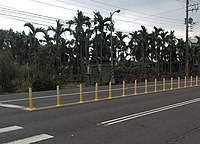 | |||
| barrier | user defined | All commonly used values according to Taginfo | ||||
This table is a wiki template with a default description in English. Editable here.
As a namespace
barrier:*=* was voted on in Proposal:New barrier types as a suffix to show access control on the barrier=* feature.
- barrier:key=*
- barrier:biometrics=*
- barrier:rfid=*
- barrier:magnetic_stripe=*
- barrier:keypad=*
- barrier:video=*
- barrier:personnel=*
The number of barrier:keypad=* surged after Lyft adopted it in 2023 on barrier=gate https://github.com/Test-DCT/OSM-LYFT-DCT/issues/29
See also
- Proposal 2008: Proposed features/barriers
- Proposal 2011: Proposed features/New barrier types
- Barriers - A barrier is a physical structure which blocks or impedes movement.
- Barrier examples - Overview table
- obstacle=* - Objective obstacles in a path (or highways) that make passage difficult.
- man_made=dyke - An embankment built to restrict the flow of water or other liquids.
- man_made=embankment - For embankments that are not symmetrical; i.e. the land is higher on one side.
- man_made=embankment embankment=yes - For embankments that are symmetrical; i.e. the surrounding land is at about the same level on both sides (use instead of barrier=embankment).
- traffic_calming=* - Features used to slow down traffic
- door=* - Specifies the type of a door
- Routing Routing obstacles and other conditions requiring special consideration
- Define barrier=* value based on images: MapRoulette challenge.
- centralkey=*
- authentication:*=*
- open=* and opening=* for cases where the barrier is always open to a certain degree















